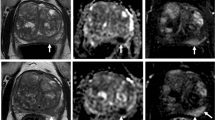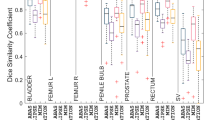Abstract
Background and objective
The magnitude of intra-fractional prostate displacement (change from initial position over time) is associated with the duration of the patient lying on the radiotherapy treatment couch. This study reports a minute-by-minute association and calculates the impact of this displacement on duration-dependent margins using real-time intra-fractional position data monitored by four-dimensional transperineal ultrasound (4D TPUS).
Materials and methods
A total of 55 patients were recruited prospectively. Intra-fractional position of the prostate was monitored in real-time using a 4D TPUS Clarity® system. A total of 1745 monitoring sessions were analysed. Van Herk’s margin recipe (2.5∑ + 1.64((σ2 + σp2)1/2 − σp)) was used to estimate the duration-dependant margins for every minute, up to the 15th minute. Linear regression analysis was then performed on the overall margins against time and direction.
Results
The mean intra-fractional position was 0.76 mm Inferior (Inf), 0 mm Lateral (Lat) and 0.94 mm Posterior (Post) at the 15th minute. A minimum margin expansion of 2.42 mm (Superior/Inf), 1.02 mm (Left/Right) and 2.65 mm (Anterior/Post) was required for an 8‑minute treatment compared to 4.29 mm (Sup/Inf), 1.84 mm (Lt/Rt) and 4.63 mm (Ant/Post) for a 15-minute treatment. The required margin expansion increased linearly (R2 = 0.99) in all directions (p < 0.01). However, while there was no statistically significant difference (p = 0.10) in the required margin expansion in the Sup/Inf and Ant/Post directions respective of the time duration, the margins were much bigger compared to those in the Lt/Rt direction (p < 0.01).
Conclusion
We report our experience in deriving the minimum duration-dependant margin to generate the required planning target volume for prostate radiotherapy. The required margin increases linearly in all directions within the 15-min duration; thus, the margin will depend on the duration of the technique chosen (IMRT/VMAT/3DCRT/proton).



Similar content being viewed by others
References
Ballhausen H, Li M, Hegemann NS, Ganswindt U, Belka C (2015) Intra-fraction motion of the prostate is a random walk. Phys Med Biol 60(2):549–563
Choi HS, Kang KM, Jeong BK, Song JH, Lee YH, Ha IB et al (2018) Analysis of motion-dependent clinical outcome of tumor tracking stereotactic body radiotherapy for prostate cancer. J Korean Med Sci 33:e107
Sihono DSK, Ehmann M, Heitmann S, von Swietochowski S, Grimm M, Boda-Heggemann J et al (2018) Determination of intrafraction prostate motion during external beam radiotherapy with a transperineal 4D ultrasound real-time tracking system. Int J Radiat Oncol Biol Phys 101:136–143
Ballhausen H, Li M, Ganswindt U, Belka C (2018) Shorter treatment times reduce the impact of intra-fractional motion: a real-time 4DUS study comparing VMAT vs. step-and-shoot IMRT for prostate cancer. Strahlenther Onkol 194:664–674
Richardson AK, Jacobs P (2017) Intrafraction monitoring of prostate motion during radiotherapy using the Clarity® autoscan transperineal ultrasound (TPUS) system. Radiography 23(4):310–313
Qi X, Gao X, Zhao B, Qin S, Zhang S (2017) Intrafractional prostate motion and dose variation during radiation therapy for prostate cancer using 4D-TPUS. Int J Radiat Oncol Biol Phys 99:e234
Pang EPP, Knight K, Hussain A, Fan Q, Baird M, Tan SXF et al (2018) Reduction of intra-fraction prostate motion – Determining optimal bladder volume and filling for prostate radiotherapy using daily 4D TPUS and CBCT. Techn Innov Pat Supp Radiat Oncol 5:9–15
Pang EPP, Knight K, Fan Q, Tan SXF, Ang KW, Master Z et al (2018) Analysis of intra-fraction prostate motion and derivation of duration-dependent margins for radiotherapy using real-time 4D ultrasound. Phys Imaging Radiat Oncol 5:102–07
Keall PJ, Colvill E, O’Brien R, Caillet V, Eade T, Kneebone A et al (2018) Electromagnetic-guided MLC tracking radiation therapy for prostate cancer patients: prospective clinical trial results. Int J Radiat Oncol Biol Phys 101:387–395
Steiner E, Georg D, Goldner G, Stock M (2013) Prostate and patient intrafraction motion: impact on treatment time-dependent planning margins for patients with endorectal balloon. Int J Radiat Oncol Biol Phys 86(4):755–761
Adamson J, Wu Q (2010) Prostate intrafraction motion assessed by simultaneous kilovoltage fluoroscopy at megavoltage delivery I: clinical observations and pattern analysis. Int J Radiat Oncol Biol Phys 78(5):1563–1570
Ballhausen H, Reiner M, Kantz S, Belka C, Sohn M (2013) The random walk model of intrafraction movement. Phys Med Biol 58:2413–2427
Ipsen S, Bruder R, O’Brien R, Keall PJ, Schweikard A, Poulsen PR (2016) Online 4D ultrasound guidance for real-time motion compensation by MLC tracking. Med Phys 43:5695
Fast MF, O’Shea TP, Nill S, Oelfke U, Harris EJ (2016) First evaluation of the feasibility of MLC tracking using ultrasound motion estimation. Med Phys 43:4628
Muller AC, Mischinger J, Klotz T et al (2016) Interdisciplinary consensus statement on indication and application of a hydrogel spacer for prostate radiotherapy based on experience in more than 250 patients. Radiol Oncol 50:329–336
Hamstra DA, Mariados N, Sylvester J et al (2017) Continued benefit to rectal separation for prostate radiation therapy: final results of phase III trial. Int J Radiat Oncol Biol Phys 97:976–985
Acknowledgements
The authors express their appreciation to Elekta Pte Ltd for providing the 4D TPUS Clarity equipment and in-house training. We also thank the clinical coordinators for facilitating the consenting process and the radiation therapists involved in the treatment process.
Funding
This study did not receive any financial support/funding.
Author information
Authors and Affiliations
Corresponding author
Ethics declarations
Conflict of interest
M.L.K. Chua reports personal fees from Astellas; personal fees from Janssen; grants and personal fees from Ferring; grants, personal fees and non-financial support from Varian; non-financial support from AstraZeneca; non-financial support from GenomeDx Biosciences; non-financial support from MedLever Inc; non-financial support from PVMed Inc.; outside the submitted work. E.P.P. Pang, K. Knight, S.Y. Park, W. Lian, Z. Master, M. Baird, J.W.X. Chan, M.L.C. Wang, T.W.K. Tan, E.T. Chua, W.S. Looi, W.L. Nei and J.K.L. Tuan declare that they have no competing interests.
Additional information
Part of the findings in this manuscript was presented at ASTRO 2019 conference in Chicago, USA, in a poster entitled: “Estimation of duration-dependent margins for prostate radiotherapy”.
Rights and permissions
About this article
Cite this article
Pang, E.P.P., Knight, K., Park, S.Y. et al. Duration-dependent margins for prostate radiotherapy—a practical motion mitigation strategy. Strahlenther Onkol 196, 657–663 (2020). https://doi.org/10.1007/s00066-019-01558-y
Received:
Accepted:
Published:
Issue Date:
DOI: https://doi.org/10.1007/s00066-019-01558-y




